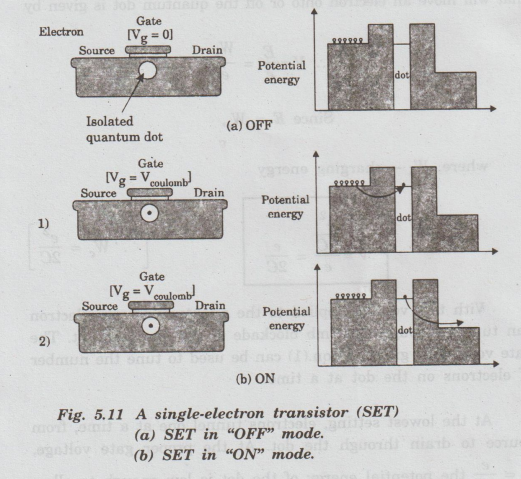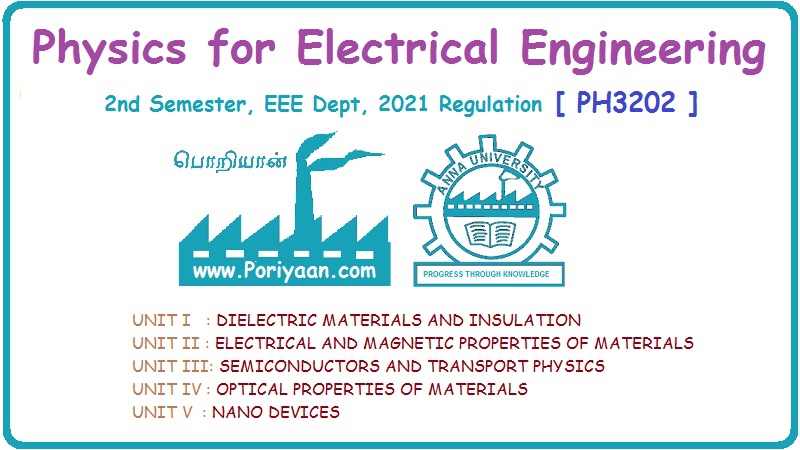Physics for Electrical Engineering: Unit V: Nano Devices
Single electron transistor (set)
Definition, Construction, Working Principle, Advantages, Limitations, Applications, Uses
SET is three-terminal switching device which can transfer electrons from source to drain one by one.
SINGLE ELECTRON TRANSISTOR (SET)
Although
a single-electron box can control the number of electrons in the quantum dot,
it does not have the properties of a switching device.
Single
switching devices are essential elements in Ultra large scale integrated
circuits (ULSIs). The single-electron switching devices are required to
utilize single electron devices in logic circuits.
Definition
SET
is three-terminal switching device which can transfer electrons from source to
drain one by one.
That
is the purpose of the SET is to individually control the tunneling of electrons
into and out of the quantum dot.
Construction
& working
The
structure of SET is shown in fig.5.11. It has the similar structure of a
conventional Field Effect Transistor (FET).

It
has tunneling junctions in place of pn-junctions and quantum dot in place of
the channel region of the FET.
To
control tunneling, a voltage bias to the gate electrode is applied. A separate
voltage bias is applied between source and drain electrodes for the current
direction.
For
current to flow, gate bias voltage must be large enough to overcome the Coulomb
blockade energy.
The
energy E needed to move a charge Q, across a potential difference V is given by
E
= VQ.
Presently,
the charge of an electron (Q= e). So, the voltage that will move an electron
onto or off the quantum dot is given by
V
= E/e = Wc / e
Since
E = Wc
where,
Wc - charging energy

With
this voltage applied to the quantum dot, an electron can tunnel through Coulomb
blockade of the quantum dot. The gate voltage as given in eqn.(1) can be used
to tune the number of electrons on the dot at a time.
At
the lowest setting, electrons tunnel one at a time, from source to drain
through the dot. At the proper gate voltage, V = e/2C the potential energy of
the dot is low enough to allow an electron to tunnel through Coulomb blockade
energy barrier to the quantum dot.
Once
the quantum dot gets an electron, its potential energy rises. Then, the
electron tunnels through the Coulomb blockade on the other side reach the lower
potential energy at the drain. Since, the dot is empty and potential is lower
again, the process repeats.
Thus,
when the gate voltage Vg is zero, no current flows. The first gate
voltage which is large enough to move an electron through the Coulomb blockade
is called VCoulomb'
For
single-electron tunneling, VR = VCoulomb'
It
If the gate voltage equals V Coulomb' + e/2C, then two electrons can
be moved on the quantum dot at a time. If the gate voltage equals
VCoulomb'
+ e/2C + e/2C = V Coulomb' +
e/C’
then
three electrons can be moved on the quantum dot at a time and so on.ten
Thus,
number of electrons in the quantum dot is controlled using the gate voltage.
These
ON and OFF states can be utilized to make an effective switch out of a SET.
The
gate voltages for a SET are a few millivolts and source-to-drain currents are
in the pico ampere range.
Advantages
•
The fast information transfer speed between cells (almost amo near light speed)
is carried carried out via via electrostatic sonsu interactions only.
•
No wire is needed between arrays. The size of each cell Dau can be as small as
2.5 nm. This made them very suitable for high density memory.
•
This can be used for the next generation quantum computer.
Limitations
•
In order to operate SET circuit at room temperature, the lao size of the
quantum dot should be smaller than 10 nm.
•
It is very hard to fabricate by traditional optical lithography and
semiconductor process.
•
The methods must be developed for connecting the individual structures into
logic circuits, and these circuits must be arranged into larger 2D patterns.
Applications
•
The main fields of application of the single electron anotransistor is used in
sensor technology and digital electronic circuits.
•
A variety of digital logic functions, including AND or NOR gates, is obtained
based on SET operating at room temperature.
•
It is used for mass data storage.
•
It is used in highly sensitive electrometer.
•
SET can be used as a temperature probe, particularly in the range of very low
temperatures.
•
SET is a suitable measurement set-up for single electron spectroscopy.
•
It
is used for the fabrication of a homo-dyn receiver operating at frequencies
between 10 and 300 MHz.
Physics for Electrical Engineering: Unit V: Nano Devices : Tag: : Definition, Construction, Working Principle, Advantages, Limitations, Applications, Uses - Single electron transistor (set)
Related Topics
Related Subjects
Physics for Electrical Engineering
PH3202 2nd Semester 2021 Regulation | 2nd Semester EEE Dept 2021 Regulation
